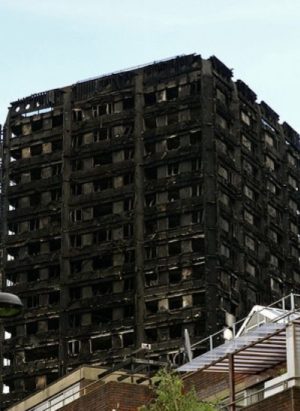You have no items in your cart. Want to get some nice things?
Go shopping  It is difficult to recognize violence, poet and dramatist Bert Brecht wrote in the middle of the 20th century. Not when it hits you with a knife or bullet – but cloaked in the habits of inequality it evades detection and thus flees justice. For a month now, London has been living with a charred ruin that testifies to that effect. I cannot begin to fathom the pain of those who died in Grenfell Tower, nor the despair of those who survived. Yet what I can do is recognize that the flames exposed a fundamental faultline: Grenfell Tower was home to those who lived there, but administered as housing. Violence festers and burns on this divide. A home is more than a roof over your head. It is a place of refuge and community, to be safeguarded and valued, in which the meanings of our lives entwine and unfold. Housing, by contrast, evokes red tape, regulations and deficit reduction. “Human beings,” as Bert Brecht observed, “live in holes, year-in year-out, which are not any friendlier than dungeons, and it is no more possible for them to get out of there than to escape dungeons. Of course, there are no jailors guarding these doors.” It is a peculiar form of homelessness that puts a roof over your head but leaves you without the power to truly inhabit, to own and trust it. His insights are as topical as ever despite the fact that he died in 1956, having himself been exiled during the Third Reich.
It is difficult to recognize violence, poet and dramatist Bert Brecht wrote in the middle of the 20th century. Not when it hits you with a knife or bullet – but cloaked in the habits of inequality it evades detection and thus flees justice. For a month now, London has been living with a charred ruin that testifies to that effect. I cannot begin to fathom the pain of those who died in Grenfell Tower, nor the despair of those who survived. Yet what I can do is recognize that the flames exposed a fundamental faultline: Grenfell Tower was home to those who lived there, but administered as housing. Violence festers and burns on this divide. A home is more than a roof over your head. It is a place of refuge and community, to be safeguarded and valued, in which the meanings of our lives entwine and unfold. Housing, by contrast, evokes red tape, regulations and deficit reduction. “Human beings,” as Bert Brecht observed, “live in holes, year-in year-out, which are not any friendlier than dungeons, and it is no more possible for them to get out of there than to escape dungeons. Of course, there are no jailors guarding these doors.” It is a peculiar form of homelessness that puts a roof over your head but leaves you without the power to truly inhabit, to own and trust it. His insights are as topical as ever despite the fact that he died in 1956, having himself been exiled during the Third Reich.
This is a cultural history of housing that kills, itself skeletal and incomplete not because of a lack of examples but because of their abundance. Writers have been exposing this particular form of violence for centuries, so let’s have a look at how their ideas can help us shape our thoughts and envision a different future. Feel free to add your own.
1. Friedrich Engels: One of the forefathers of socialism, he remains famous for his descriptions of the squalor of industrialized England in the 19th century. The poverty he encounters there pierces any sense of human dignity. He records a woman’s body found covered in feathers for want of even a blanket, laid out in the room where her son sleeps. “Close to the splendid houses of the rich such a lurking-place of the bitterest poverty may often be found.” Written in Manchester from 1842–44 this was an eye-opener for the revolutionary movement, and whole passages of the 1848 Communist Manifesto, which he co-penned with Karl Marx, read like an echo of what is arguably Engels’ most important study. It was translated into English only in 1885, reaching an English reading public that had so far relied on Charles Dickens for a window into the lives of their exploited neighbours. Yet where the literature of pauperism saw only the human suffering which squalor caused, Engels defined its revolutionary potential. He speaks of social murder, a crime committed when thousands of people, toddlers and old men who have just reached their forties, fall victim to conditions of production which do not even cover the most basic needs. For Engels, the housing crisis is a necessary cog in the machine of the capitalist system. In his own country, unlike in the UK, a Marxist alternative was tried in Eastern Germany after World War II. With the usual German rigour, it failed as much as it had been hailed initially. Yet echoes of his sense that housing kills continue to reverberate.
2. Jacob Riis: How the Other Half Lives: Studies among the Tenements of New York is one of the earliest milestones of photojournalism. It was published in 1890 when the U.S. Census Bureau ranked New York as the most densely populated city in the United States—1.5 million inhabitants – and sparked a public awakening about housing conditions. Riis had immigrated to the United States from Denmark in the 1970s and knew first-hand what it meant to live in the underbelly of American urbanism. This is a journey through Blindman’s Alley and Chinatown, following in the footsteps of Italian immigrants, Jewish schoolchildren and Polish cigar makers. If this makes the book sound a little too ethnically segregated, then be safe in the knowledge that Riis knew how to play his audience. But humanitarian though his project was in many ways, a saint he certainly was not. This can lead to the clear-sightedness of bitter disillusionment, as in his comments on race: “The colour line must be drawn through the tenements to give the picture it’s proper shading. The landlord does the drawing, does it with an absence of pretence, a frankness of despotism, that is nothing if not brutal.” Yet his cynicism cannot hide the anti-Semitic bias in particular that runs through his prose. How the Other Half Lives is a child of its time, for better and for worse. Sensationalist and indignant in turns, his photographs offer an unprecedented perspective on the forgotten population that fueled New York’s rise to the world city we know today. Yet as he says himself, your circumstances define who you are – and the mindset of Riis, the self-styled observer, is also a symptom of the battles fought in the crowded Lower East Side tenement houses.
3. Richard Wright:
“The kitchenette is the author of glad tidings that new suckers are in town, ready to be cheated, plundered, and put in their places.
The kitchenette is our prison, our death sentence without trial, the new form of mob violence that assaults not only the lone individual, but all of us, in ceaseless attacks.
[…] The Kitchenette is the funnel through which our pulverized lives flow to ruin and death on the city pavements, at a profit…”
This is the voice of Richard Wright denouncing the conditions faced by African American workers who migrated North in the early 20th century. His fierce prose attempted to re-write US-American historiography, which had long been (and often still is) white by default. Yet his 1941 12 Million Black Voices. A Folk History of the Negro in the United States is no standard history writing, nor does it aim to be, as new perspectives warrant new forms. He plunges into the collective psychological impact of city tenements unfit for human housing. Wright’s kitchenettes embody deprivation, overcrowded and “so loud that even a pistol shot is smothered,” ensuring that those who start out from the bottom of the social ladder have their personalities blighted and their dreams destroyed while they are young. It is the energy of Wright’s writing itself that breaks through this double-bind. He sets the forcefields of poetry up against the power of the (white) property owners. His history ends on a point of hope and strength, surprisingly so, and has only recently been re-discovered by readers and critics after being out of print.
4. Ralph Ellison: Unforgettably, his Invisible Man lives in an ultra-lit-up basement, enjoying his life, as he puts it, “with the compliments of Monopolated Light & Power.” He has installed 1369 light bulbs in what would otherwise resemble a hole in the ground. Thus quite literally usurping the power of a big company and putting it to his own uses, he plays with the subversion of power in more ways than one. “I’ve illuminated the blackness of my invisibility,” he claims, exposing a space between hypervisibility and invisibility that has been thrust upon him. He proceeds to inhabit this ambiguity morally, socially and artistically. Of course, Invisible Man is not a text about housing per se. But the narrator’s basement is so emblematic that I think it is a worthy conclusion to my list. It might be a tongue-in-cheek protest against those who Wright would call the “Bosses of the Buildings.” More importantly, though, this space of both darkness and light is the artistic home of the whole novel, literally and figuratively. It is a place of independence.

About Katharina Donn
Katharina Donn’s first book, A Poetics of Trauma after 9/11", has been published by Routledge in 2016. She works internationally, between Germany and London, and is employed as associate lecturer and post-doctoral research fellow at the American Studies Department at the University of Augsburg. She has also held positions with the University of Texas at Austin and with the Institute of Advanced Studies at UCL. She enjoys being a transnational traveller, commuting between Germany and the UK, and works with the Brilliant Club at London state schools to advocate equality in education.




